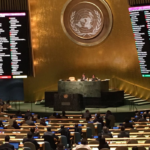If midnight is the end of the world as we know it, in 2017, the world is 2.5 minutes away from the hour. The Science and Security Board of the prestigious journal The Bulletin of Atomic Scientists, in consultation with its board of sponsors that includes 15 Nobel laureates, decides annually whether to move the hands of their symbolic “Doomsday Clock” or leave them as is. This year, the clock hasbeen reset and is now at 11 hours, 57 minutes and 30 seconds, the closest it has been to midnight since 1953.
The Doomsday Clock was introduced exactly 70 years ago, in 1947, as a serious warning that the world may be building up to a global nuclear war, by a group of concerned scientists who ironically participated in the making of the world’s first-ever nuclear weapons under the Manhattan Project. Over the past seven decades, while the clock continues to be a universally recognised indicator of the world’s vulnerability to nuclear Armageddon, other human-induced catastrophes such as climate change during the past decade, have also been included as factors pushing us towards the end of civilisation.

Tensions in South Asia
Besides the renewed nuclear arms race between the US and Russia, the hawkish statements of US President Donald Trump and the two nuclear tests conducted by North Korea in 2016, this year’s Doomsday Clock Statement mentions the “simmering tensions between nuclear-armed India and Pakistan”. It refers to the “threats of nuclear warfare” hanging in the background “as Pakistan and India faced each other warily across the Line of Control in Kashmir”, a reference to the surgical strikes by the Indian military across the LoC on September 29.
The statement also mentions the militant attacks on two Indian army bases in 2016 – the September 18 Uri attack that killed 20 soldiers and the Nagrota attack on November 29, in which seven soldiers died – that led to the exchange of not-so-veiled nuclear threats in South Asia.
India and Pakistan last found mention in the Doomsday Clock Statement in 1998, the year both countries conducted nuclear tests. In that year, the Doomsday Clock was brought down to 9 minutes to midnight from 14 minutes in 1995, which reflected the conclusion of The the Comprehensive Nuclear-Test-Ban Treaty negotiations and the end of cold-war nuclear rivalry.
The Bulletin identifies South Asia as a key driver of the global nuclear risk, as the region has witnessed unparalleled brinkmanship over atomic weapons in 2016. While the Indian Defence Minister Manohar Parrikar made frivolous statements about revising India’s nuclear doctrines of No-First-Use and credible minimum deterrence, his counterpart in Pakistan raised concerns internationally when he threatened Israel with nuclear war, merely over a fake tweet!
Moreover, be it the reference to Balochistan or the issue of sharing water from the Indus river, India’s Prime Minister led the frontal diplomatic offensives against Pakistan. The surgical strikes have been perceived internationally as having lowered the nuclear threshold as such conventional strikes were thought difficult, if not impossible, under the shadow of nuclear weapons.
Heed the warning
The mention of South Asia in the Doomsday Clock Statement should act as a stern warning to governments and the civil society in the region. The dangers of nuclear war in this part of the world are real and graver than ever before.
Today, South Asia is the only region that hosts two adjacent nuclear-armed states with a history of conventional wars and decades-long border disputes and conflicts. The military stability that the proponents of nuclear weapons claimed the region would be bestowed with after the 1998 tests has remained elusive. The military budgets of India as well as Pakistan have grown exponentially and India has been among the top five weapons importers in the world for the past several years.
The nuclear arsenals of both the countries have been expanding rapidly – both quantitatively and qualitatively. Pakistan has been investing heavily in tactical nuclear weapons, to be used at battlefields to offset India’s conventional military superiority and has been producing more nuclear weapons annually. Meanwhile, India’s fissile material stockpile has been rising steadily thanks to the larger number of nuclear power reactors.
On average, India and Pakistan have flight-tested one nuclear-capable missile every year since 1998. A 2012 report by the Nobel-winning International Physicians for Prevention of Nuclear Weapons warned of a severe nuclear war-induced famine in South Asia that would kill a staggering two billion people in its hypothetical study on the consequences of a nuclear exchange in the region.
Furthermore, it concluded that even a middle-scale nuclear war in South Asia would unleash irreversible climatic effect, impacts of which will be felt far beyond the region.
In 2016, India made a crucial departure from its earlier stance of not escalating conventional war because of the presence of nuclear weapons in the region. Both India and Pakistan are now actively at loggerheads and the political leadership in the two countries have made repeated references to nuclear weapons.
The frivolous language in which these inhuman weapons get talked about in the region is simply frightening. The politics of war-mongering by the ruling party in India has vitiated the atmosphere and made introducing new nuclear confidence- building measures politically unpalatable for the current government. In these circumstances, we would ignore the warning reflected by the latest Doomsday Clock announcement only at our own grave peril.
– Kumar Sundaram


